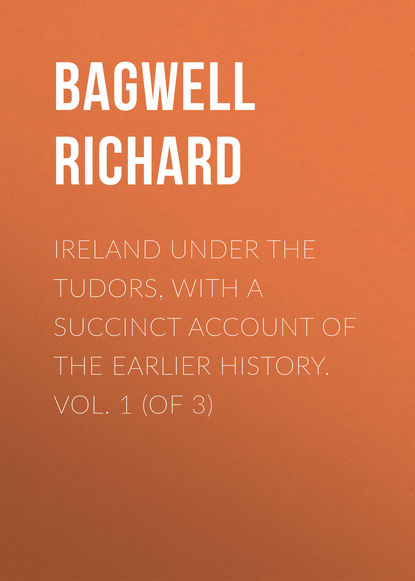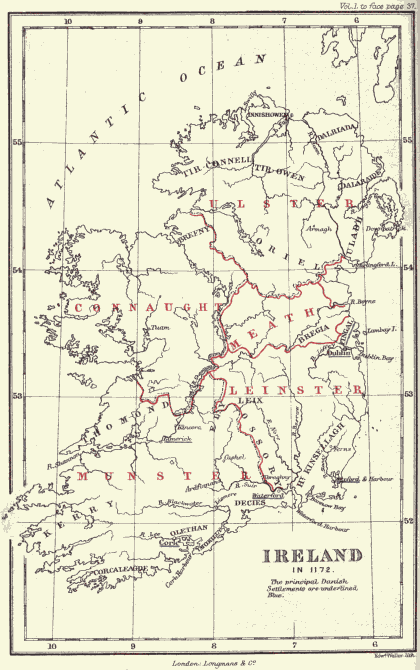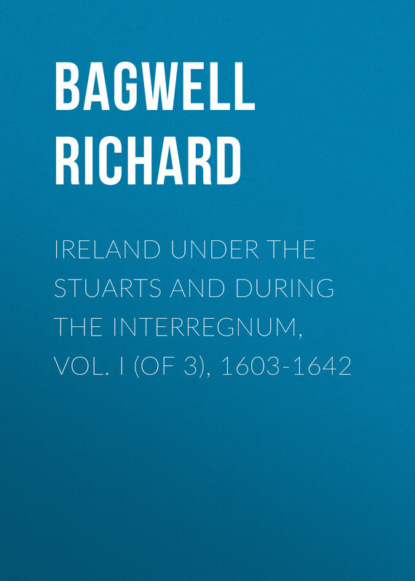
Полная версия
Ireland under the Tudors, with a Succinct Account of the Earlier History. Vol. 1 (of 3)
10
‘Marriages in Ireland,’ says Dr. Sullivan, ‘were not regulated by canon law. The Irish marriage customs were in full force long after the Norman conquest. According to these customs, which appear to have been wholly uninfluenced by the canon law, bastardy was entirely different from what that term implied in countries under canon law, and in modern times. The Irish marriage customs should consequently be taken into account here, as they sanctioned a kind of polygamy, divorce, &c. See also the excommunication in 1282, by the Archbishop of Canterbury against Llewellyn, Prince of Wales, at the request of Edward I., in which the marriage customs of the Welsh, identical with those of the Irish, constitute one of the charges.’
11
Le Résolution des justices touchant le Irish custome de gavelkind. Reported by Sir John Davies, A.G., 3 Jac. i.
12
Dr. Sullivan believes the story of the decision against Columba to be a mere myth.
13
‘The Irish Church,’ says Dr. Sullivan, ‘had undoubtedly two distinct phases of monasticism: one that of the Patrician period – an obscure but highly important and interesting phase; the other, that of the sixth and subsequent centuries, to which the Irish missionaries belonged.’
14
‘Besides,’ says Dr. Sullivan, ‘the monastic bishop proper, who furnished the wandering Scotic bishops of the Middle Ages, there is a later development of a higher church organisation in the tribal bishop, who was a close approximation to a diocesan bishop. The tribal bishop was a bishop who had jurisdiction over the whole of a Tuath, and sometimes even a Mór Tuath. The growth of territorial jurisdiction is well marked by the prestige attached to the office – the bishop ranked in fact almost on a level with the chief, and was entitled to the same legal retinue. Many of the ancient dioceses, and some of the existing ones, e. g. Ross, Kilmacduagh, Kilfenora, represent ancient Tuaths, or tribe territories. Several deaneries were former dioceses, and are co-extensive with ancient Tuatha.
15
Dr. Sullivan warns me not to attribute too much influence to the Danish Church. ‘The tribe-bishop,’ he says, ‘was a much earlier development, and proves the growth of diocesan jurisdiction and the consequent merging of the Irish Church in the Latin Church. The acceptance of the Roman time for celebrating Easter by the Irish Church and the constant intercourse between Ireland and the Continent had brought the Irish Church fully under Roman supremacy three and a half centuries earlier. What really took place in the early part of the twelfth century was the more complete adoption of the organisation of the Western Church, and of the principles of the canon law; and especially the granting of lands and charters to the Church in the same way as in feudal lands. The marriage of Irish princes with Saxon and other foreign princesses, and the growth of towns which helped to relax its rigid tribal system, did more than the Danish Church.’ The chief towns were, however, of Danish origin.
16
The account which Giraldus gives of Turgesius is funny, but worthless.
17
Reeves’s Adamnan, p. 332 n.
18
Wars of the Gaedhill with the Gaill, chap. xxxvi.
19
Wars of the Gaedhill with the Gaill, chap. xl.
20
The quotations are from Burnt Njal, chap. cliii.
21
Burnt Njal, chap. cliv.
22
Ibid., chap. clvi. Wars of the Gaedhill with the Gaill, chaps. xcviii. and xcix. Annals of Lough Cé, pp. 7-13.
23
Burnt Njal, chap. clvi.
24
Many details about the Hiberno-Norse coins are to be found in Worsaae.
25
Book of Rights, pp. 225 sqq., and O’Donovan’s preface.
26
See Hook’s Lives of Lanfranc, Anselm, and Ralph d’Eures. Translations of the letters mentioned in the text may be found in King’s Primer of the Irish Church; most of the originals are printed in Ussher’s Sylloge.
27
The Irish always called Dublin Ath-cliath, or the Ford of Hurdles.
28
The great mine of knowledge about the Irish Scandinavians is Todd’s Wars of the Gaedhill with the Gaill, in the Record series. I have also used Dasent’s Story of Burnt Njal, and Anderson’s Orkneyinga Saga. Haliday’s Scandinavian Kingdom of Dublin, edited by Mr. J. P. Prendergast, is a good modern book. Worsaae’s Danes and Norwegians is said to be somewhat fanciful, but it contains information not readily accessible elsewhere.

29
Matthew Paris calls the Irish ‘bestiales.’
30
See the Senchus Mór, ii. 225.
31
Giraldus, Ex. Hib. lib. i. cap. 2.
32
In Webb’s Compendium of Irish Biography is a carefully compiled catalogue of Nesta’s children and grandchildren. I have generally followed it, noting, however, that Fitz-Stephen’s children cannot be held legitimate in the face of Giraldus’ distinct statement.
33
The details of Henry’s preparations may be studied in Sweetman’s Calendar of Documents.
34
In narrating the events of Henry II.’s reign, I have generally followed Giraldus Cambrensis, checking him by references to Hoveden and Regan. The Expugnatio may be considered a fanciful book in some ways. But if we eliminate everything supernatural, and make some allowance for the writer’s prejudices, I see no reason to question his good faith. Of the native Irish he knew little, but the invaders were his neighbours, friends, and relations. Fitz-Stephen and the other descendants of Nesta may be unduly praised, Fitz-Adelm perhaps unduly blamed; but, after all, this is no more than may be said against most historians of their own times. Giraldus was undoubtedly an observer of first-rate power.
35
The quotations are from Gilbert’s Historic and Municipal Documents of Ireland, pp. xxviii. and xxx.
36
Hardiman’s History of Galway contains as much as most readers will care to know about that town. The following distich makes it possible to remember the tribes: —
Athy, Blake, Bodkin, Browne, Deane, Darcy, Lynch, Joyce, Kirwan, Martin, Morris, Skerrett, French.
To which Ffont or Faunt must be added
37
The quarrels of Waterford with the O’Driscolls are given in the Calendar of Carew MSS., Miscellaneous vol. p. 470. Smith refers to a MS. in Trinity College.
38
Besides those in the Statute Book many Irish Acts of Edward IV.’s reign may be studied in Hardiman’s Statute of Kilkenny.
39
Stubbs’s Const. Hist., chap. xv.; Lynch’s Feudal Dignities, chaps. iii. and xi.
40
Sweetman’s Calendar of Documents, 1289; Lynch, supra.
41
The record is printed from the Black Book of Christ Church, in the Miscellany of the Irish Archæological Society.
42
Lynch, ut supra.
43
Lynch, ut supra; Lodge’s Register; Hardiman’s Statute of Kilkenny.
44
The names of those summoned to the Parliament of 1311 are printed by Lynch, chap. ii.; the names of those who attended in 1560 are in Tracts Relating to Ireland, vol. ii., Appendix II.
45
Cotton’s Fasti; Alemand’s Histoire Monastique; Lynch, chaps. iii. and vii.
46
Irish Statutes, 28 Hen. VIII. cap. 12.
47
See the list of chief governors in Harris’s Ware; Borlase’s Reduction of Ireland; Lodge’s Patentee Officers; and Gilbert’s Viceroys.





